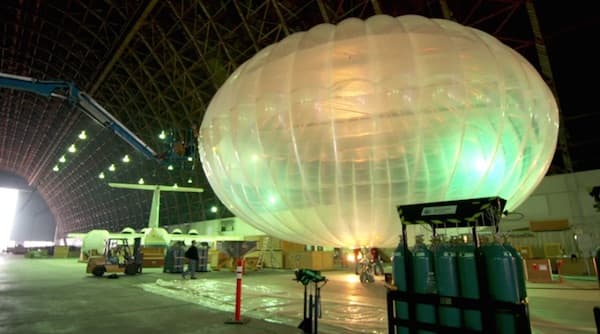Google 'Project Loon' Is Coming To India With BSNL To Offer Internet Via Balloons
Google's innovative way to offer the Internet via balloons, called Project Loon is now coming to India. We learn that the government of India has approved the pilot of the project in India and BSNL is likely to be the official <a href="https://www.crazyengineers.com/threads/project-loon-googles-balloon-powered-global-internet.68523">Project Loon : Google's Balloon Powered Global Internet</a> Partner by offering 2.6 GHz broadband spectrum. Back in February, we had informed that the Google's ambitious project is likely to <a href="https://www.crazyengineers.com/threads/google-balloons-project-loon-is-coming-to-india.78815">Google Balloons (Project Loon) Is Coming To India</a>.
ToI informs that Google approached the government for approval to offer Internet via balloons and drones. A committee under the chairmanship of secretary, DeitY has been formed to work on it.
The uninitiated may note that Google's Project Loon is an innovative project developed by Google X Labs, that aims to offer wireless Internet to all parts of the world via balloons floating in the air. These balloons carry all the necessary equipment, along with solar powered batteries, to establish a network among themselves and transmit the signals to the ground.

The technology used by Google is similar to that of 4G LTE but with an added advantage of eliminating the towers. Google informs that each of their balloon will hover at an altitude of about 20 km above the ground and cover an area of about 40 Km diameter to beam 4G signals. Each of the balloon can stay afloat for about 6 months and engineers have developed hardware and software to predict where the balloons will land so that they can be retrieved.
Google partners with the local 4G service providers and beam the Internet directly to the subscribers. Google's role in providing Internet service will be that of the technology enabler and not the ISP that provides the actual service. Google however, has already been offering Internet services in select regions in USA via it's subsidiary named 'Google Fibre'.
The committee formed by DeitY (Department of Electronics and Information Technology) will study various aspects of the Project Loon. It will identify the locations for the trials of the service and also act as a mediator for communication and coordination among various Government departments and agencies.
Google's been conducting trials of their project in <a href="https://www.crazyengineers.com/threads/google-project-loon-update-thousands-of-balloons-are-getting-ready.80123">Google Project Loon Update: Thousands Of Balloons Are Getting Ready!</a> and even in <a href="https://www.crazyengineers.com/threads/project-loon-update-google-collaborates-with-french-space-agency.77757">Project Loon Update: Google Collaborates With French Space Agency</a> It's tying up with local telecom service providers to conduct limited trials and is getting the balloons ready.
Google's proposal to offer the Internet via drones has not been approved by the government yet. Facebook too has announced its own plans to connect the world with Internet through <a href="https://www.crazyengineers.com/threads/facebook-drones-vs-google-balloons-the-race-to-beam-internet-from-the-sky-intensifies.76792">Facebook Drones Vs. Google Balloons - The Race To Beam Internet From The Sky Intensifies</a>.
Source: #-Link-Snipped-#
ToI informs that Google approached the government for approval to offer Internet via balloons and drones. A committee under the chairmanship of secretary, DeitY has been formed to work on it.
The uninitiated may note that Google's Project Loon is an innovative project developed by Google X Labs, that aims to offer wireless Internet to all parts of the world via balloons floating in the air. These balloons carry all the necessary equipment, along with solar powered batteries, to establish a network among themselves and transmit the signals to the ground.

The technology used by Google is similar to that of 4G LTE but with an added advantage of eliminating the towers. Google informs that each of their balloon will hover at an altitude of about 20 km above the ground and cover an area of about 40 Km diameter to beam 4G signals. Each of the balloon can stay afloat for about 6 months and engineers have developed hardware and software to predict where the balloons will land so that they can be retrieved.
Google partners with the local 4G service providers and beam the Internet directly to the subscribers. Google's role in providing Internet service will be that of the technology enabler and not the ISP that provides the actual service. Google however, has already been offering Internet services in select regions in USA via it's subsidiary named 'Google Fibre'.
The committee formed by DeitY (Department of Electronics and Information Technology) will study various aspects of the Project Loon. It will identify the locations for the trials of the service and also act as a mediator for communication and coordination among various Government departments and agencies.
Google's been conducting trials of their project in <a href="https://www.crazyengineers.com/threads/google-project-loon-update-thousands-of-balloons-are-getting-ready.80123">Google Project Loon Update: Thousands Of Balloons Are Getting Ready!</a> and even in <a href="https://www.crazyengineers.com/threads/project-loon-update-google-collaborates-with-french-space-agency.77757">Project Loon Update: Google Collaborates With French Space Agency</a> It's tying up with local telecom service providers to conduct limited trials and is getting the balloons ready.
Source: #-Link-Snipped-#
0
